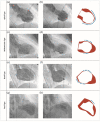Takotsubo Syndrome: A Review of Presentation, Diagnosis and Management
- PMID: 35002350
- PMCID: PMC8733363
- DOI: 10.1177/11795468211065782
Takotsubo Syndrome: A Review of Presentation, Diagnosis and Management
Abstract
Takotsubo Syndrome (TTS) is a condition of transient left ventricular dysfunction that is typically triggered by emotional or physical stress. Since first described in Japan in 1990, it has increasingly been recognised in clinical practice, accounting for up to 2% of Acute Coronary Syndrome (ACS) presentations. In fact, the clinical presentation can be indistinguishable from a myocardial infarction. Although current evidence suggests a catecholamine induced myocardial stunning, the pathophysiological mechanisms remain unknown. Interestingly, it is more common in woman, particularly those who are post-menopausal. This review aims to summarise the current research and provide an overview of the diagnostic strategies and treatment options.
Keywords: Takotsubo cardiomyopathy; Takotsubo syndrome; broken heart syndrome; stress cardiomyopathy.
© The Author(s) 2022.
Conflict of interest statement
Declaration of conflicting interests: The author(s) declared no potential conflicts of interest with respect to the research, authorship, and/or publication of this article.
Figures




Similar articles
-
Takotsubo syndrome: unravelling the enigma of the broken heart syndrome?-a narrative review.Cardiovasc Diagn Ther. 2023 Dec 15;13(6):1080-1103. doi: 10.21037/cdt-23-283. Epub 2023 Dec 8. Cardiovasc Diagn Ther. 2023. PMID: 38162098 Free PMC article. Review.
-
Shattered Hearts: Exploring Takotsubo Cardiomyopathy Triggered by a Mechanical Fall in an 88-Year-Old Woman.Cureus. 2025 Apr 20;17(4):e82651. doi: 10.7759/cureus.82651. eCollection 2025 Apr. Cureus. 2025. PMID: 40400887 Free PMC article.
-
Takotsubo Syndrome: Cardiotoxic Stress in the COVID Era.Mayo Clin Proc Innov Qual Outcomes. 2020 Dec;4(6):775-785. doi: 10.1016/j.mayocpiqo.2020.08.008. Epub 2020 Nov 30. Mayo Clin Proc Innov Qual Outcomes. 2020. PMID: 33283161 Free PMC article. Review.
-
Takotsubo Cardiomyopathy.Eur Cardiol. 2015 Jul;10(1):25-30. doi: 10.15420/ecr.2015.10.01.25. Eur Cardiol. 2015. PMID: 30310419 Free PMC article. Review.
-
Novel Understanding of Takotsubo Syndrome.Int Heart J. 2018 Mar 30;59(2):250-255. doi: 10.1536/ihj.17-586. Epub 2018 Mar 5. Int Heart J. 2018. PMID: 29503405 Review.
Cited by
-
An Unlikely Cause of Chest Pain: Recurrent Takotsubo Cardiomyopathy.J Community Hosp Intern Med Perspect. 2024 Sep 9;14(5):114-119. doi: 10.55729/2000-9666.1394. eCollection 2024. J Community Hosp Intern Med Perspect. 2024. PMID: 39399193 Free PMC article.
-
Advanced Cardiac Imaging and Women's Chest Pain: A Question of Gender.Diagnostics (Basel). 2023 Aug 7;13(15):2611. doi: 10.3390/diagnostics13152611. Diagnostics (Basel). 2023. PMID: 37568974 Free PMC article. Review.
-
Takotsubo cardiomyopathy prevalence and associated factors in patients presenting with a clinical picture of acute myocardial infarction in Palestine.Egypt Heart J. 2023 Aug 14;75(1):71. doi: 10.1186/s43044-023-00399-6. Egypt Heart J. 2023. PMID: 37578674 Free PMC article.
-
An Unusual Presentation of Takotsubo Syndrome in a Young Female of Middle Eastern Origin.Clin Case Rep. 2025 Mar 6;13(3):e70166. doi: 10.1002/ccr3.70166. eCollection 2025 Mar. Clin Case Rep. 2025. PMID: 40051897 Free PMC article.
-
Stress-Induced Cardiomyopathy Mimicking Acute Coronary Syndrome in a High-Risk Female Patient: A Case Report.Cureus. 2025 Apr 20;17(4):e82618. doi: 10.7759/cureus.82618. eCollection 2025 Apr. Cureus. 2025. PMID: 40395239 Free PMC article.
References
-
- Dote K, Sato H, Tateishi H, Uchida T, Ishihara M. Myocardial stunning due to simultaneous multivessel coronary spasms: a review of 5 cases. J Cardiol. 1991;21:203-214. - PubMed
-
- Minhas AS, Hughey AB, Kolias TJ. Nationwide trends in reported incidence of takotsubo cardiomyopathy from 2006 to 2012. Am J Cardiol. 2015;116:1128-1131. - PubMed
-
- Gianni M, Dentali F, Grandi AM, Sumner G, Hiralal R, Lonn E. Apical ballooning syndrome or takotsubo cardiomyopathy: a systematic review. Eur Heart J. 2006;27:1523-1529. - PubMed
-
- Redfors B, Vedad R, Angerås O, et al.. Mortality in takotsubo syndrome is similar to mortality in myocardial infarction - a report from the SWEDEHEART registry. Int J Cardiol. 2015;185:282-289. - PubMed
Publication types
LinkOut - more resources
Full Text Sources

